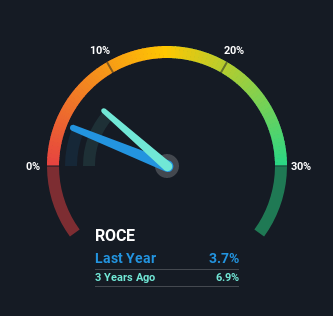Returns On Capital Signal Difficult Times Ahead For Weiqiao Textile (HKG:2698)
To avoid investing in a business that's in decline, there's a few financial metrics that can provide early indications of aging. When we see a declining return on capital employed (ROCE) in conjunction with a declining base of capital employed, that's often how a mature business shows signs of aging. This indicates to us that the business is not only shrinking the size of its net assets, but its returns are falling as well. Having said that, after a brief look, Weiqiao Textile (HKG:2698) we aren't filled with optimism, but let's investigate further.
Understanding Return On Capital Employed (ROCE)
Just to clarify if you're unsure, ROCE is a metric for evaluating how much pre-tax income (in percentage terms) a company earns on the capital invested in its business. Analysts use this formula to calculate it for Weiqiao Textile:
Return on Capital Employed = Earnings Before Interest and Tax (EBIT) ÷ (Total Assets - Current Liabilities)
0.037 = CN¥728m ÷ (CN¥25b - CN¥5.5b) (Based on the trailing twelve months to December 2021).
Thus, Weiqiao Textile has an ROCE of 3.7%. Ultimately, that's a low return and it under-performs the Luxury industry average of 7.6%.
See our latest analysis for Weiqiao Textile

While the past is not representative of the future, it can be helpful to know how a company has performed historically, which is why we have this chart above. If you're interested in investigating Weiqiao Textile's past further, check out this free graph of past earnings, revenue and cash flow.
How Are Returns Trending?
The trend of ROCE at Weiqiao Textile is showing some signs of weakness. To be more specific, today's ROCE was 7.1% five years ago but has since fallen to 3.7%. In addition to that, Weiqiao Textile is now employing 21% less capital than it was five years ago. When you see both ROCE and capital employed diminishing, it can often be a sign of a mature and shrinking business that might be in structural decline. If these underlying trends continue, we wouldn't be too optimistic going forward.
Our Take On Weiqiao Textile's ROCE
To see Weiqiao Textile reducing the capital employed in the business in tandem with diminishing returns, is concerning. Long term shareholders who've owned the stock over the last five years have experienced a 46% depreciation in their investment, so it appears the market might not like these trends either. That being the case, unless the underlying trends revert to a more positive trajectory, we'd consider looking elsewhere.
If you want to know some of the risks facing Weiqiao Textile we've found 2 warning signs (1 is concerning!) that you should be aware of before investing here.
While Weiqiao Textile isn't earning the highest return, check out this free list of companies that are earning high returns on equity with solid balance sheets.
Valuation is complex, but we're here to simplify it.
Discover if Weiqiao Textile might be undervalued or overvalued with our detailed analysis, featuring fair value estimates, potential risks, dividends, insider trades, and its financial condition.
Access Free AnalysisHave feedback on this article? Concerned about the content? Get in touch with us directly. Alternatively, email editorial-team (at) simplywallst.com.
This article by Simply Wall St is general in nature. We provide commentary based on historical data and analyst forecasts only using an unbiased methodology and our articles are not intended to be financial advice. It does not constitute a recommendation to buy or sell any stock, and does not take account of your objectives, or your financial situation. We aim to bring you long-term focused analysis driven by fundamental data. Note that our analysis may not factor in the latest price-sensitive company announcements or qualitative material. Simply Wall St has no position in any stocks mentioned.
About SEHK:2698
Weiqiao Textile
Weiqiao Textile Company Limited, together with its subsidiaries, engages in the manufacture and sale of cotton yarns, grey fabrics, and denims in Mainland China, Hong Kong, East Asia, Southeast Asia, South Asia, and internationally.
Adequate balance sheet and slightly overvalued.
Market Insights
Community Narratives



